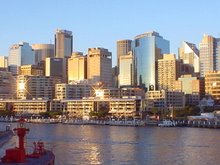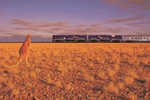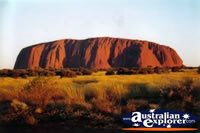
From one end of the walkway to the other is about 20 mins.
I’m fascinated by the Bridge. That’s the Sydney icon for me. As Bryson notes, it’s always popping up in your line of sight – above a leafy residential street, over the top of low buildings, end of busy avenue, as a ferry rounds a point, … It’s known affectionately as the “coat hanger,” and you can see why. Its magnitude - the massiveness of the pylons and girders - relative to a fairly short harbour-crossing makes it stand out. It’s not one of those wispy modern bridges you see – the ones that impress you with their apparent lightness and hide their real strength.

This bridge carries 10 lanes of traffic, I think, plus a light-rail line, and a pedestrian lane on one side, bike lane on other side.

This is our last morning in the Lord Nelson. We do both breakfast and lunch there – finally have a meat pie. Quite meaty and well-spiced. In between we manage to use our phone card successfully – repeated failures the day before, at a cost of AU50c each! The card, though, is phenomenal once you get connected – 300 mins. for US$8. Good to talk to the folks at home. We also check e-mail and I blog-post our Sydney notes and pictures for your edification and pleasure. [Note added later. A week later we - Dick, actually - get the idea to call the card's customer service number. Turns out we've been interpreting things wrong. The card has access numbers listed by cities. That means use them only in those cities. We've been using the access number of the nearest city when we've been out in the bush. Wrong. That requires more money in the machine for a long distance call. We've been putting in 50c, as in Sydney, so, boom, when that's spent the line is disconnected. There's another access number for calls outside the listed cities. So, as of today, 9/18, we're using the phone card correctly. I think we're paying more for it, though, when we have to use the national number. But, it's worth it to hear the voices of all of you to whom we have been fortunate enough to speak.]
Across the way from the Lord Nelson is a historical observatory, now a museum, and we spend an hour there. Lots of telescopes and associated gear plus a very interesting video is playing on the voyage of James Cook that led to the discovery of Australia. His reason for being in the south Pacific was to observe the “transit of Venus.” That’s when Venus passes in front of the sun, from the right perspective on earth. This happens twice in an eight-year span about once a century. I don’t have even a glimmer of the mathematics/geometry involved, but by measuring this transit it’s possible to get an accurate estimate of the distance from the sun to the earth and from that be able to measure distances among the other planets more accurately than would otherwise be possible.
Now, I’m leading up to some interesting statistics. There’s a famous paper in which successive estimates, by different laboratories, of the earth-sun distance are compared. Each lab, as should be the case with scientific work, included “error bars” to express how uncertain their measurements were. It turned out, though, that each successive estimate did not fall in the error bars of the preceding lab’s estimate. So, the error bars weren’t really capturing how uncertain an estimate was. Important sources of uncertainty had been left out. The author’s point was that better methods were needed to evaluate uncertainty.
OK, sorry for the diversion. Back to Cook’s voyage. After catching the Venus transit, he sailed on SW and found New Zealand. Sailed its whole circumference and mapped it, I believe. Milford Sound is a fiord on the west side of the south island – very scenic and much visited. When Susie and I were there in 2003 we were told that the entrance to the Sound is difficult to see from sea and so Cook missed it. In the video, Cook and company saw the fiord and the botanist on board wanted to land and explore. Cook said, No, too dangerous. Fiords are too deep to anchor in so they would be hard-pressed to keep from being dashed on the rocks. Of course, he won the argument.
After doing NZ, the next issue was how to go home to England: east, around S. America, or west, around Africa. If west, they would look for what was then called “New Holland,” parts of which had been discovered by earlier European explorers. The decision was West. Lo and behold, land ho! That’s where the video ended. Cook named their landing point, Botany Bay, for his botanist, then sailed up and mapped the east coast and claimed the land for England. He missed the Sydney Harbour entrance. When the first load of prisoner-settlers came, they didn’t like Botany Bay and found their way north a bit to what was to become Sydney Harbour.
Here's a last morning's view of Sydney. Really a great city.
Cheers,
Rob






No comments:
Post a Comment